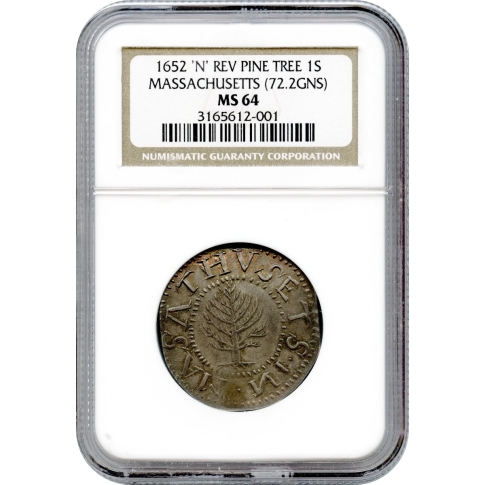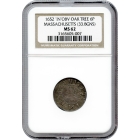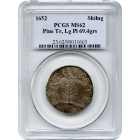1652 Massachusetts Pine Tree Shilling, 'N' Reverse, 72.2gns NGC MS64
This 1652 Massachusetts Bay Colony, Pine Tree shilling is a Noe-4 variety and one of the finest known. It weights 72.2 grains. It displays lovely light gray surfaces with iridescent gold and blue highlights. A well-struck and completely full tree is evident. There are complete legends on both obverse and reverse. The N-4 variety is quite distinctive, characterized by the reversed "N" in NEWENGLAND. The left and right edges are cut straight, undoubtedly the result of adjusting at the Mint as this piece were of full statutory weight. There is a slight, figure S-shaped bend in the planchet, when viewed from the edge. This prime specimen has a typical die state, with pronounced breaks in the left field beside the date and denomination. This example is finer than the Noe plate coin in his book, the Roper Collection example, lot 29, and the equal to the Picker Collection example, Lot 23, especially in terms of sharpness. Originally purchased by Ambassador R. Henry Norweb from Hollinbeck Stamp & Coin Company on May 1, 1956. Last offered in the 1987 Norweb Collection sale.
In 1652, John Hull and Robert Sanderson were appointed mint masters for Massachusetts Bay Colony. During that same year, John Hull states in his diary, that, “upon occasion of much counterfeit coin brought into the country, and much loss accruing in that respect (and that did occasion a stoppage of trade), the general court ordered a mint to be set up, and to coin it, bringing it up to the sterling standard for fineness; and, for weight, every shilling to be three pennyweight.“
The mint-house was located on Mr. Hull’s estate, the land to be conveyed to the government, at a fair evaluation, when his office of mint master expired.
Joseph Jenckes cut dies for the first coins, such as the Pine Tree shilling. While there is no direct evidence for this claim, there is circumstantial evidence that Jenckes created steel punches, blank dies, and other tools for the mint. The design was promptly put in execution. The date attached to the coins is 1652, and was never changed, although the coinage was continued for several years. The first order of the court was, that the coins should be, “for form, flat and square on the sides, And stamped on the one side with NE, and on the other side with XIId., VId., and IIId.” It was afterwards ordered, that, to prevent “clipping or washing,” they should have “a double ring on either side, with this inscription: Massachusetts, and a tree in the center, on the one side; and New England, and the date of the year, on the other side.” They were also to have “a private mark, known only to the governor, and the sworn officers of the mint.” This latter condition was to thwart any counterfeiting attempts that could prove to be devastating to the psychology of the community.
In 1663, the court ordered a coinage of Two Penny pieces. All persons had the liberty to bring in bullion, plate, and Spanish pieces, and have them converted into Massachusetts coins; but, in 1654, it was enacted, that to “send, carry, or transport, out of this jurisdiction, any of the money” so coined, exceeding 20 shillings for necessary expenses, should subject the offender to the confiscation of all his visible estate.
According to tradition, Joseph Jenckes cut dies for the first coins minted in America, such as the Pine Tree shilling. While there is no direct evidence for this claim, there is circumstantial evidence that Jenckes created steel punches, blank dies, and other tools for the mint.
These coins carried distinctive obverse and reverse types, identifying them as native products of the newly planted English colony. The coins circulated widely at the time, from French Canada in the north to the West Indies in the south, from Boston in the west to London in the east.
When Massachusetts first struck its coins in 1652, it embarked on a business venture that was without precedent in the New World. To realize just how much of a numismatic milestone this was, we need to remember what America looked like when the coins were first made. For a Boston Puritan, America was a wild and wooly place full of danger, as well as promise.
In 1652, the main colony of Massachusetts included Boston and 15 recently founded neighboring towns. Boston’s total population was only around 3,000 souls, hardly enough, one might have thought, to need their own mint and coinage. Outside the small, scattered English towns lived the native peoples, seen by the Europeans settlers as savages and, even worse, non-Christians.
| PCGS # | 45372 |
|---|---|
| Grading Service | NONE |
| Year of Issue | NONE |
| Grade | NONE |
| Denom Type | N/A |
| Numeric Denomination | 1 Shilling |
| Mint Location | NONE |
| Designation | NONE |
| Circ/UnCirc | Not Specified |
| Strike Type | N/A |
| Holder Variety | MASATHVSETS Pine Tree 1 Shilling, 'N' Reverse, 72.2gns |
| Grade Add On | NONE |
| Holder Type | N/A |





